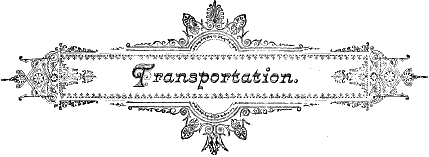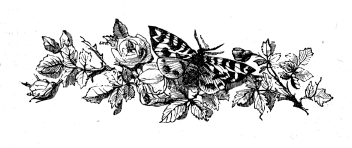NEGenWeb Project
Resource Center
On-Line Library
 |
 |
|
The Burlington & Missouri River Railroad in Nebraska.
|
||
|
|
 |
TRANSPORTATION. |
 |
at Rulo The length of the main line in Nebraska from Plattsmouth to the Colorado line, passing through Lincoln, Hastings and other principal points, is 364.52 miles, and all other branches in this State 1755.78 miles. The road is ballasted with stone, gravel, cinders and earth. Of the 2,120.30 miles of road in Nebraska, 1,600.08 miles are laid with steel rails, the rest being laid with iron. The total mileage comprised in the Burlington system west of the Missouri River is 2,778.78 miles. When it is remembered that the above-stated Nebraska mileage of the Burlington & Missouri River Railroad constitutes but little short of one-half of the entire railroad mileage of the State, it will readily be seen how important a factor this great railroad must have been in that recent marvelous development of material resources which has raised Nebraska to her present proud position in the sisterhood of States. Indeed the growth of the State in population, wealth, and everything that goes to the making-up of a great commonwealth, has throughout been coincident with the extension of this great railroad system. It is only necessary to look back over a brief period of seven years, to find the aggregate railroad mileage of the State less by 200 miles than the present mileage of this one line. Two years ago, even, large portions of the State, in nowise inferior in their capabilities to the best settled and most productive sections along the Missouri River, were entirely destitute of railroad facilities, and were consequently cut off, not only from the great markets of the continent, but even from the chief centers of population in the State itself. But by a truly marvelous transformation these outlying regions have been brought near, and the magnificent display of agricultural products that was made at the State fair of 1888, by counties among the most recently settled and the farthest west, abundantly justified the enterprise that has been displayed, and forever set at rest all those lingering fallacies that would have limited the agricultural possibilities of the western half of the State. The road has practically three trunk lines running the entire length of the State. These are connected by a network of branches so perfectly organized that there are no two points of importance within its territory between which the great railroad may not be said to have an air line. No fewer than fifty-seven counties of the State are reached by these various lines, and those numerous additional feeders which have been thrown out, with the object of bringing the various products of all the best sections of the State within reach of that great Burlington system, which carries the greatest grain and live-stock market in the world a larger proportion of its supplies than is handled by any other road. It is a fact, largely by virtue of its relations with time Chicago, Burlington and Quincy and other roads, constituting what is popularly known as the Burlington Route, that the Burlington & Missouri River Railroad is enabled to afford the people of Nebraska the unequaled railroad facilities they enjoy, laying hold with one hand upon the great mountain chain of the continent. It stretches over the vast agricultural region of the West, to pay tribute with the other to that most magnificent of all inland waterways, the Great Lake System of America, besides connecting with those various steel highways which forum the chief lines of travel, and for the larger half of the year, the only commercial arteries between Chicago and the Atlantic seaboard. The only line of which this can be said, it naturally commands not only an immense freight traffic, but a through passenger travel of great volume and importance, so much so, indeed, that it has twelve superbly appointed express passenger trains traversing Nebraska from end to end every day in the year. Of these six run between Denver and Chicago, four between Denver and Kansas City, amid two between Denver and St. Louis. The Denver & Chicago trains run via Omaha, Neb., commercial metropolis; Lincoln, its beautiful and flourishing capital, and many other rapidly growing towns and cities in the State. From the capital of the State there radiate no fewer than six separate lines, in as many different directions. At Nebraska City one of its lines crosses the magnificent steel bridge, recently built at that point by the Chicago, Burlington & Quincy Railroad, and connects with the trains of that company to and from Chicago at Red Oak, Iowa, but the facts will be sufficiently apparent from the foregoing general statements, as will also the absolute identity of |
||
|
|
 |
TRANSPORTATION. |
 |
interests that exist between the flourishing State of Nebraska and that great railroad system which has done so much to promote its development.
The Missouri Pacific Railroad.
The preliminary steps to build the road were taken, and it has since gradually extended its lines, like the arteries and veins of the human system, until it has encompassed in its range the best portions of Missouri, Kansas and Nebraska, and has even reached out and tapped the large commercial centers of Texas and Colorado. Its splendid and far-reaching management extends to its patrons both in freight and passenger traffic the best facilities for reaching the seaboard and the great Eastern marts of trade. The growth and development of the Missouri Pacific system have been rapid and fully abreast of the times. Its local business is enormous and rapidly increasing. In respect to its through business no other road or system in Nebraska is better equipped than this. Its steel-rail tracks, well-ballasted road-beds, and superior passenger coaches, constitute it one of the greatest railroad systems of the West. Its superb fast train between St. Louis and Denver via Kansas City and Pueblo, is unquestionably the most elegant and best equipped train of any road which enters the peerless city of the plains. It runs more passenger trains and finer coaches between St. Louis and Kansas City than any other road. It has contributed in a wonderful degree toward the building up of the various cities along its numerous lines. Kansas City has felt its influence as much as any other road centering in that metropolis, as its lines lead into the heart of the coal and iron fields of Missouri. It is thus enabled to lay down at the doors of the growing towns of the West those two essential factors in the building up of a new country, more quickly and cheaper than almost any other road can do. It gives to its numerous and rapidly increasing patronage in Nebraska and Kansas unsurpassed facilities for reaching the great health resorts of Arkansas and Texas. Over its line from Omaha to St. Louis, about 500 miles in extent, it runs the finest trains between those two cities, passing through Weeping Water, Nebraska City and Falls City, in Nebraska, and St. Joseph, Atchison and Leavenworth, before reaching Kansas City. The length of its main line and branches in Nebraska is 322 miles, its northern terminus being Omaha, whose connections are made with all the roads centering in that metropolis. The line from Omaha to Falls City is 115 miles; the Crete branch 58 miles; Lincoln to Auburn, 76 miles; Warwick to Prosser, 73 miles. Various extensions and additions are constantly being made in Nebraska. Thus it will be seen that this road already taps the two leading cities in the State, Omaha and Lincoln, besides Nebraska City, rapidly growing into importance, likewise Hastings. Thus it will be seen that this is one of the important roads centering in Omaha, the metropolis of Nebraska; on account of its extensive mileage and the ramification of the system, it is destined to promote in a large degree the development o the material interests of the country through which it passes.
Chicago, Rock Island & Pacific.
|
||
|
|
 |
TRANSPORTATION. |
 |
of the State another direct communication with the great lumber and other interests of Chicago and Kansas City, and the great lake and seaboard marts of trade
Union Pacific, THE PATHFINDER OF THE OVERLAND ROUTE.
|
||
|
|


